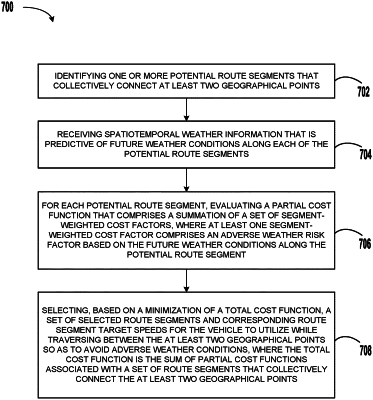| CPC G01C 21/3697 (2013.01) [G01C 21/3461 (2013.01); G01C 21/3469 (2013.01); G01C 21/3492 (2013.01); G05D 1/0287 (2013.01); G08G 1/22 (2013.01)] | 20 Claims |

|
1. A method performed by a computing system configured to control operation of a vehicle, the method comprising:
identifying one or more potential route segments that collectively connect at least two geographical points;
receiving spatiotemporal weather information that is predictive of future weather conditions along each of the potential route segments;
for each particular potential route segment of the one or more potential route segments, determining a partial cost function based on a summation of a plurality of segment-weighted cost factors associated with the particular potential route segment, wherein each segment-weighted cost factor of the plurality of segment-weighted cost factors comprises (i) a respective cost factor that is a function of speed of the vehicle and (ii) a respective weight that is based on an importance of the respective cost factor, wherein at least one segment-weighted cost factor comprises an adverse weather risk factor, and wherein the adverse weather risk factor is based on a probability as a function of speed of the vehicle of the vehicle encountering the future weather conditions along the particular potential route segment;
selecting, based on a minimization of a total cost function, a set of selected route segments and corresponding route segment target speeds for the vehicle to utilize while traversing between the at least two geographical points, wherein the total cost function is the sum of partial cost functions associated with a set of route segments that collectively connect the at least two geographical points, and wherein a route segment target speed for one of the selected route segments in the set is selected such that the vehicle avoids an adverse weather condition in another of the selected route segments in the set; and
controlling the vehicle to operate along the set of selected route segments at the corresponding route segment target speeds between the at least two geographical points.
|